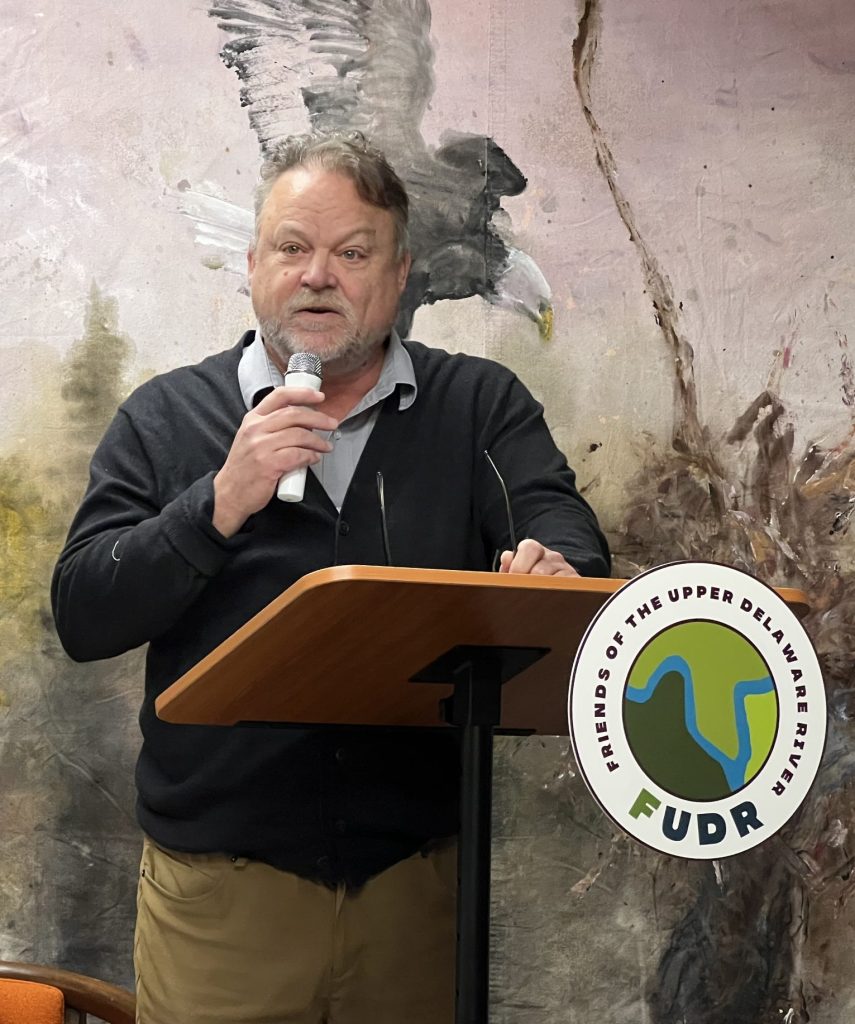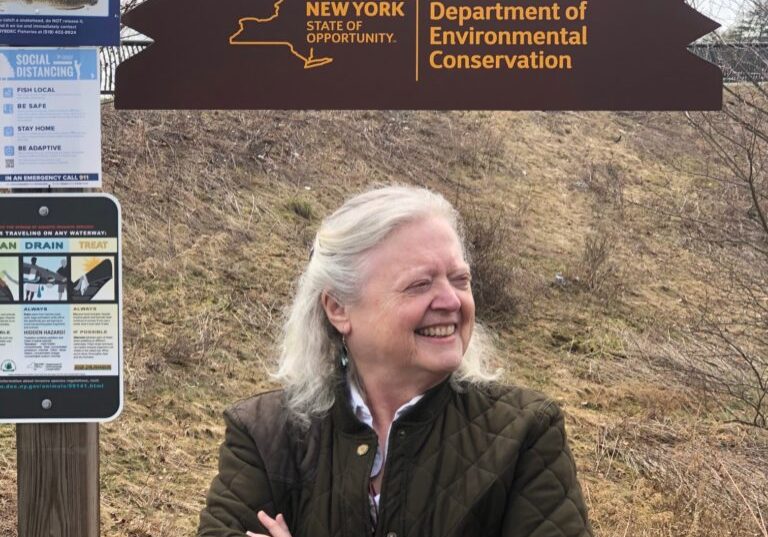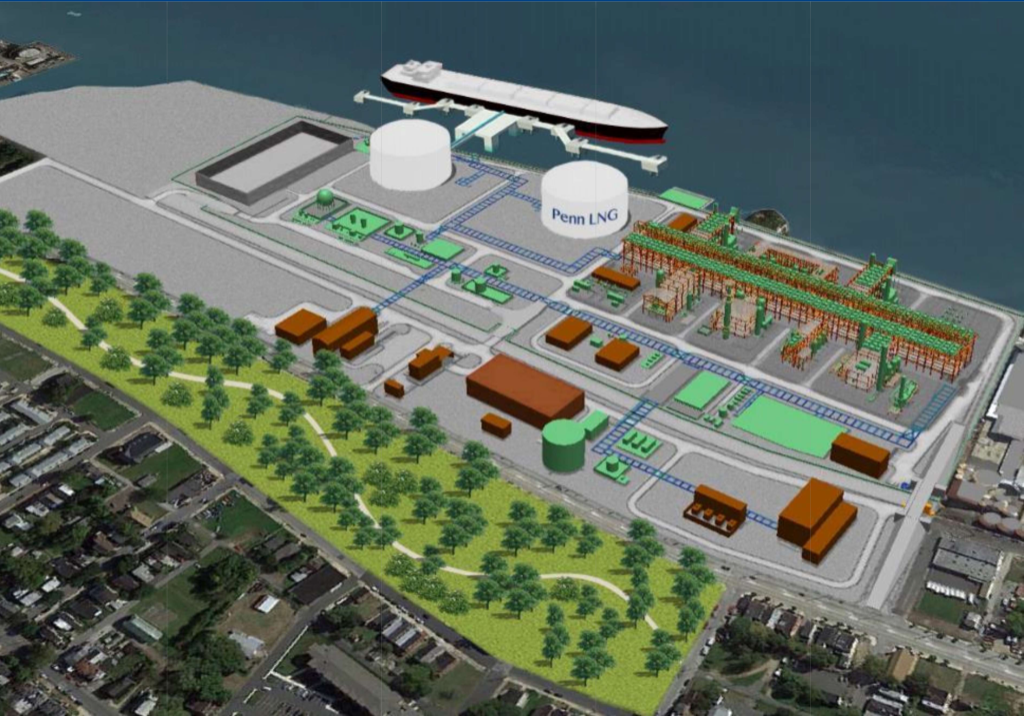
Upper Delaware River gets lots of love and attention at Hancock conference
| October 28, 2023
“Water, Water Everywhere” is the annual conference of the Friends of the Upper Delaware River.
Congressman Marc Molinaro (NY-19) was supposed to appear in person as the headliner for the kick-off of this year’s conference, which was held this week in Hancock, N.Y.
Instead, he sent a video from Washington, D.C., where he was, as he said, “locked in a room” and referred to the ongoing attempt to elect a House speaker as “a bit of a mess.”
(That was on Tuesday. The new speaker, Mike Johnson, was elected the next day.)
In the video, Molinaro applauded the efforts of FUDR in its work to build a coalition to press Congress to find money to fund efforts to make the river “safe, accessible and cleaner.”
Molinaro collaborated with Congressman Brian Fitzpatrick (PA-1), a Democrat, (they’re both members of the bipartisan Delaware River Watershed Congressional Caucus) to support funding for the Delaware River Basin Restoration Program.
Molinaro signed onto the request to boost funding for the program from the current House appropriation of $11.5 million to $15 million, which matches the Senate’s appropriation.
Though not talked about at this conference, Molinaro led a bipartisan effort to defeat a Republican amendment to the Energy and Water Development and Appropriations bill that would have defunded the Delaware River Basin Commission.
[Read more about the DRBC’s struggle to get its members (the four states and the federal government) to provide promised funding.]
“The Delaware River Basin Commission protects clean drinking water and improves climate resiliency, flood mitigation and wildlife protection. I will never hesitate to vote against a measure that threatens these undertakings — and I proudly work across party lines to do so,” Molinaro said in a statement.
Jeff Skelding, executive director of FUDR, said later: “Molinaro has been good to us. All of our congressmen have been good to us.”
Back to the video, Molinaro was impatient to get back to his role on the House Agriculture Committee and work on the 2023 Farm Bill, which will address flooding and flooding preparedness.
His support of the Delaware River Basin Restoration Program is clearly one of the reasons he was invited to speak, since a good chunk of the conference’s first day was reporting on projects partially funded by those federal dollars.
DRBRP projects abound
To date, 13 projects to repair infrastructure have been supported by DRBRP funds — half of the project’s cost come from federal dollars and half from local sources.
Molly Oliver, policy director of FUDR, gave a rundown about how projects are picked, with projects selected according to how they met twin goals of improving habitat for fish as well as other critters in the ecosystem and also how the money would address costly infrastructure projects in towns in Sullivan and Delaware Counties.
The projects reconnected 13 miles of streams and improved nine habitats by repairing culverts and bridges. Stream restoration can help prevent or minimize the impacts when flooding happens and whenever possible, projects are designed to store excess flood water, sturdy enough to withstand the flood event and provide robust habitat for aquatic species even during times when the water is high and fast-moving.
Tracy Brown, restoration manager in New York and Connecticut for Trout Unlimited, reviewed some of the sites, highlighting a new river access site in Highland in Sullivan County.
Another of the new initiatives supported by DRBRP is the Neversink Watershed Management Plan. Sullivan County received the funds and the project is spearheaded by Jillian Pagnotti, the watershed program coordinator for FUDR.
Still in its early stages with public input and meetings, the plan will serve as a blueprint for the management of the land and water of the Neversink.
Diversifying representation
Next up in the busy schedule was a review of two FUDR projects that target young people. The first is the Bill Canfield Fly Fishing Camp, which is offered twice each summer and aims to introduce young people (12-17) to fly fishing.
And the Upper Delaware River Conservation Corps: Young adults with an interest in environmental careers spend summers working on clean-ups, invasive species remediation and culvert assessments. Their work helps build the roster of projects considered for those stream restoration dollars.
Then, we turned our attention to J.E.D.I. — not the lightsaber folks — but initials that represent Justice, Equity, Diversity and Inclusion.
Board members Christine LaRocca and Clay Smith explained that it was important for the work of protecting rivers that all stakeholders are engaged. Certainly, the anglers that form the heart of FUDR are vital but a healthy future demands engagement with the broader community.
They even pointed out that the all-white (largely male) board might need to figure out how to become more representative of the whole river community.
Many of the FUDR partners were part of a lightning round highlighting accomplishments and priorities including: Kelly Knutson, director, Coalition for the Delaware River Watershed; Julie Tighe, president, New York League of Conservation Voters; Gayle Killam, Water Policy Pathways; Kyle Sandusky, Orange County Land Trust; Trey Talley, Delaware Highlands Conservancy; and Erin McGrath, Audubon New York.
Studies, FFMP and introductions
Yet another study was highlighted: Evaluating the Climate Resilience of Headwaters and Potential Downstream Effects.
The Academy of Natural Sciences of Drexel University in Philadelphia, Bloomsburg University of Pennsylvania and Water Policy Pathways have joined forces to study data from four collection sites in the upper Delaware to better understand resilience and future impacts of climate change.
Closing out the first day, Laurie Ramie, executive director of the Upper Delaware Council, gave a report on the UDC’s funding problems with the states of New York and Pennsylvania. Read more here.
Then, calling herself the “new-ish” superintendent of the Upper Delaware Scenic and Recreational River, Lindsey Kurnath, who been here less than a year, introduced herself and talked a bit about her background in the National Park Service.
Tim Leonard of the National Parks Conservation Association explained its role, developed alongside the Park Service but separate from it, and how it works to advocate for the Park Service.
The next day was really focused on the river itself.
First with a presentation by Peter Kolesar, who gave answers to the main questions people have about the Flexible Flow Management Program. It’s certainly confusing but you can read more about it here.
To see this session with Kolesar and Brenan Tarrier, an engineer with the Division of Water, New York State Department of Environmental Conservation, check out FUDR’s website — www.fudr.org.
FUDR plans to publish a video of the conference. If you’re confused about the FFMP, Kolesar answers the seven main questions people are always asking FUDR about it.
The hot topic these days in the upper river is the Delaware Aqueduct shutdown, which was postponed again until next year because of problems with water leaking back into the tunnel.
It has to be dry for the safety of the people who will be working on it, and really, hardly surprising that the leaks FROM the tunnel into the Hudson River turn into leaks INTO the tunnel from that same river when there’s less water in the tunnel.
Brent Gotsch, technical adviser for reservoir releases for the New York City Department of Environmental Protection, acknowledged upriver concerns about flooding but said there were lots of safety protocols in place, which would make flooding less likely.
He also acknowledged that Mother Nature does have to play her part.
If there’s a theme to this conference is that any positive change in the upper river is the result of time spent planning.
The next presentation: Joint Fisheries Investigation Plan and UDR Wild Trout Management Plan talked about the first stage of a plan for wild trout — getting accurate information from sampling the trout population through electrofishing and angler information.
I imagine we’ll see that plan for wild trout in one of the future FUDR conferences.
And getting ever closer to the anglers’ hearts, the next presentation was about a long-term study with FUDR and Cornell University (privately funded) to answer the question, “What’s happening with the insect hatches on the river?” Still getting started.
State of the river
And the last presentation was from Skelding about the state of the river.
He talked about a “double-edged sword”: “As the river gets more love and attention in the form of dollars to improve fishing, the pressure from increased tourism is putting pressure on the river, with anglers, paddlers and kayakers crowding certain segments.”
FUDR has developed a “River Etiquette” guide available on its website. And there’s another edge to that magical sword since increased tourism means dollars in local cash registers, a real benefit to the economically pinched upper river.
He also noted that when he first came here, he thought there’s be “lots of science.” There wasn’t then to his surprise, but there is now — just look at this conference.
And the science he explained, underpins plans and justifies to the state and the feds as well as private foundations that there is a need for money in the upper river.
Planning and funding go hand in hand.
He quoted someone as saying, “Vision without funding is hallucination.”


![DC_Image [Image 4_Assunpink Meets Delaware] meets Delaware The Assunpink Creek on its its way to meet the Delaware River. The creek passes through woods, industrial and commercial areas and spots both sparkling and filled with litter.](https://delawarecurrents.org/wp-content/uploads/bb-plugin/cache/DC_Image-4_Assunpink-meets-Delaware-1024x768-landscape-14f069364113da5e8c145e04c9f2367c-.jpg)



